Comet 2011 W3 (Lovejoy) continues to “Wow!” amateur astronomers who don’t mind getting up to look for the comet in the pre-dawn sky. This morning (23 December 2011 AEST time), the comet was reported as having a 16 degree tail – that is the same as 32 Full Moons lined up side by side! Experienced amateur astronomers have reported the comet as appearing like the light from a distant spotlight beaming high into the dawn sky – with the exception that the ‘beam’ of light is curved.
And the good news (fingers crossed) is that one comet watcher (J. Bortle) who has seen a number of sun-grazing comets is expecting that the tail should be visible for the next two weeks (with the proviso that the tail will slowly fade in brightness). That makes it a great ‘Christmas’ comet … and beyond. Dave Herald (Canberra Astronomical Society) has also pointed out that “…the comet (specifically, its nucleus) gets to its most southerly point on Jan 8, at declination –88 deg. That is, for several weeks after about New Years day the comet will be circumpolar, and therefore visible all night…“. Not bad for a comet that survived a 140, 000 kilometer close encounter with the Sun (confirming that it is a member of the Kreutz comet family).
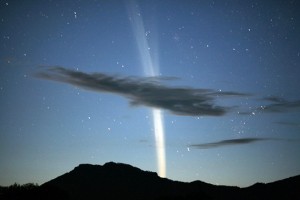
The above image, taken by Robert H. McNaught 20km west of Siding Spring Observatory on the morning of Wednesday 21 December shows how spectacular the comet currently is. More of his images can be found here on his website. The brightness of the comet in real life is reported as being as bright as parts of the Milky Way – making it easy to view assuming you have clear skies and are away from bright city lights.
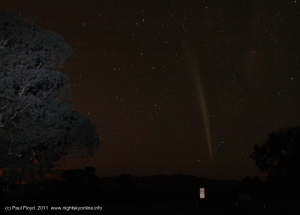
Clearly, if you live in the Southern hemisphere and want to see what may be a ‘once in a lifetime comet’, it is worth getting up in the morning to look for the comet. Unfortunately, with morning twilight occurring so early, this means you need to get up at around 3 am AEST (4 am AEDT) if you live in Canberra – which is when astronomical twilight starts (for maximum sky darkness). Use the below charts for the period Saturday 24 December through to Wednesday 28 December 2011 to assist you where to look regardless of where you live in Eastern Australia.

Above: Finder chart for Saturday 24 December 2011
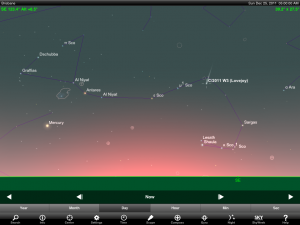
Above: Finder chart for Sunday 25 December 2011
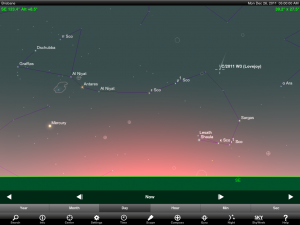
Above: Finder chart for Monday 26 December 2011
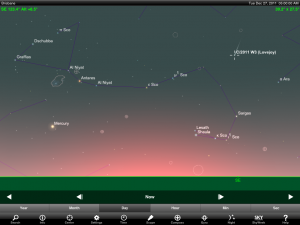
Above: Finder chart for Tuesday 27 December 2011

Above: Finder chart for Wednesday 28 December 2011
What happened to the companion comet of Lovejoy?
Thanks to your information I got some great images this morning – http://www.flickr.com/photos/25223017@N00/
Hello, my name is Nidal. ive got a question about the visibilty of the comet lovejoy in venezuela. comet Mcnaught got me crazy in the year 2007, when i couldnt see it, and now its the wonderful comet love joy that i want to see, but hoping to know if it is visible to the country in where i am, venezuela, and if yes, where exactly should i poit my view into the sky? thank you very much, would be more than happy to get the answer.
Nidal,
The comet rises tomorrow morning at 4.48 am local time (26 December 2011) in the South East from Caracas. Even with clear skies, you may not see the comet as the tail is angled towards the horizon. Atmospheric extinction (of the light) may mean that the faint tail may not be visible visually. I would still look and take a photograph. Some people have found that they have not seen the comet visually but it has shown up in a photograph.
Regards,
Paul Floyd.
John,
Glad that you found my site helpful.
Regards,
Paul Floyd.
Brad,
Sorry I can’t help with that question. The only thing I can suggest is doing a Google search to see what information you can find. The other thing would be to go to the SOHO spacecraft website. If you can remember when you remember reading about a companion object, you could look through the archive images to see what turns up.
SOHO is a joint NASA/ESA mission that constantly monitors the Sun (a satellite in space in a special orbit that lets it constantly point its instruments at the Sun). It constantly images comets diving into the Sun.
Regards,
Paul Floyd.
Paul Floyd
Thank you very much. Now, I can sleep peacefully, without having to wake up again, trying to search for the comet, sitting in the cool weather on the roof. Though i would love to see it! Buts its okay, at least, i have seen some photos, and its magnificent!
Hope to have an email, for me to message you at the times I have some questions, If you please. I’ve been checking the website spaceweather.com for 7 years, and many times i have critical questions in mind.
Thank you again for your help. Merry Christmas
Nidal,
Not a problem.
Regards,
Paul Floyd.
That comet had to be very big or more likely very solid as in a chunk of iron. Just imagine the velocity of that comet in the perigee of that orbit!
\
Hi Paul!
Congrats for your website, it has really been of help for me since nothing about Joyride has been published here in Uruguay. Last night I meant to look for the coment and take pictures but we had some clouds so I didn’t see it. Tonight… well, tomorrow morning (Dec 26), I’ll make another try but I would like to know if you can tell me at what time will the comet rise in this latitudes, and if its will be possible to see it with the naked eye. I hope not to bother you!!!
Many tahnks in advance!!!
Cheers, Mariana.
LOL!!!!!!!!!!!!!!!!!!! I mean… Lovejoy!!!!!!!!!!!!!
Hi, I live in Barbados and would love to see Comet Lovejoy. Can you tell me if the comet is visible from my area or if it will be. Thank you and Happy Holidays!
Can I see it from Oklahoma?